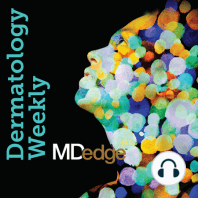29 min listen

Anti-inflammatory effects of low-dose naltrexone, plus morning and evening skin protection
Anti-inflammatory effects of low-dose naltrexone, plus morning and evening skin protection
ratings:
Length:
22 minutes
Released:
Feb 27, 2020
Format:
Podcast episode
Description
Low-dose naltrexone can suppress inflammatory markers, making it a potential therapy for some inflammatory skin conditions with a pruritic component. In this resident takeover, Dr. Daniel Mazori talks to Dr. Nadine Shabeeb about the benefits of off-label low-dose naltrexone (LDN) for the treatment of inflammatory skin conditions. “These anti-inflammatory effects aren’t seen at the higher doses of naltrexone; they’re only seen at the lower dose,” Dr. Shabeeb notes. She provides a practical perspective on prescribing LDN in the dermatology setting and discusses how to counsel patients about potential side effects, including concerns about its abuse potential. * * * We also bring you the latest in dermatology news and research: 1. Advising patients on morning and evening skin protectionMDedge Dermatology Editor Elizabeth Mechcatie speaks with Dr. Brooke C. Sikora about what clinicians can recommend for their patients for skin protection, both in the morning and in the evening. 2. Patient counseling about expectations with noninvasive skin tightening is key Dr. Nazanin Saedi advised that it is important to counsel patients about the degree of improvement to expect with noninvasive skin-tightening procedures. 3. Banning indoor tanning devices could save lives and money Banning indoor tanning devices outright in the United States, Canada, and Europe could prevent as many as 448,000 melanomas and save billions of dollars. * * * Things you will learn in this episode: Naltrexone is approved by the U.S. Food and Drug Administration to treat alcohol and opioid addiction. At its approved dose of 50-100 mg/day, naltrexone blocks opioid effects for 24 hours. In dermatology, naltrexone is used off-label at lower doses of 1.5-4.5 mg/day. “At this dose, naltrexone only binds partially to the opioid receptors, so this ends up leading to a temporary opioid blockade and ultimately increases endogenous endorphins.” Dermatologic conditions that may benefit from LDN include Hailey-Hailey disease, lichen planopilaris, psoriasis, and pruritus. Low-dose naltrexone has a favorable side-effect profile. Known adverse effects include sleep disturbances with vivid dreams and gastrointestinal tract upset. Low-dose naltrexone can alter thyroid hormone levels, especially in patients with a history of thyroid disease. “If they haven’t had a normal TSH [thyroid-stimulating hormone test] in the past year, then you can consider checking one at baseline and then check every 3 or 4 months for patients who do have a history of thyroid disease while they’re on treatment,” Dr. Shabeeb advises. “I’d also recommend counseling patients about symptoms related to hyper- and hypothyroidism so that they’re aware of symptoms to look out for.” There is no known abuse potential for LDN, but it is important to ask patients if they are using any opiates or opioid blockers before prescribing it. “If [LDN is] taken with an opiate, it can cause withdrawal symptoms and also decrease the effectiveness of the opiate, and if it’s taken with other opioid blockers, there’s also a higher risk for opioid withdrawal,” Dr. Shabeeb explains. Patients should be counseled that the cost of LDN will not be covered by insurance because it has no FDA-approved dermatologic indications. There is a lot of potential for LDN in the treatment of inflammatory skin diseases, but current research is limited to case report and case series; therefore, more data is needed. * * * Hosts: Nick Andrews; Daniel R. Mazori, MD (State University of New York, Brooklyn) Guests: Nadine Shabeeb, MD, MPH (University of Wisconsin Hospital and Clinics, Madison); Brooke C. Sikora, MD, is in private practice in Chestnut Hill, Pa.; Nazanin Saedi, MD (Jefferson University Hospitals, Philadelphia Show notes by: Alicia Sonners, Melissa Sears, Elizabeth Mechcatie * * * You can find more of our podcasts at http://www.mdedge.com/podcasts Email the show: podcasts@mdedge.com Interact with us on Twitter: @MDedgeDerm
Released:
Feb 27, 2020
Format:
Podcast episode
Titles in the series (100)
Resident Takeover: Prescribing combined OCs; contact dermatitis tips; fetal isotretinoin exposure: The official dermatology podcast of MDedge by Dermatology Weekly